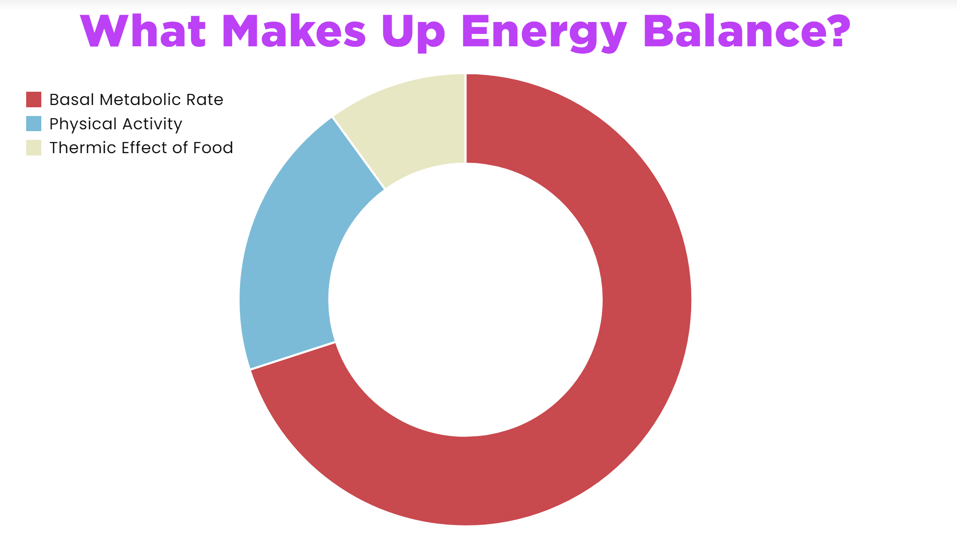Training plateaus can be hard to manage. We lose motivation, belief and self-confidence. We can...
NUTRITION BASICS: ENERGY BALANCE
‘Energy cannot be created or destroyed, only transferred from one form to another’
This is the first law of thermodynamics, which is a key principle from the laws of physics which governs energy.
What do we mean by energy?
Food and drink contain potential energy, measured in Calories which we use to fuel our everyday actions.
As the first law of thermodynamics suggests, we can’t create this energy for our bodies out of nothing, so energy transfers from food and drink to our bodies to enable us to function and carry out everyday activities.
Have you ever wondered why when you look at food packing calories comes under ‘energy’?
That is because a calorie isn’t a physical object, rather a measurement of heat.
One calorie is the amount of energy required to heat one gram of water by one degree Celsius.
The calorie content is often given in kcals, which is short for kilocalories and is just another word for Calories. So, 1,000 Calories will be written as 1,000 kcal.
Energy balance 101
Energy balance is the relationship between the energy we take in through food and the energy we expend through physical activity and bodily functions. It’s a simple equation but has profound implications on our bodyweight and health.
Weight change = calories in – calories out.
Calories/Energy In: This refers to the calories you consume through eating and drinking.
Calories/Energy Out: This encompasses the calories you burn, including daily living activities, exercise, and even the energy used to digest food.
The Balancing Act
The state of your energy balance determines whether you lose weight, gain weight, or maintain your current weight:
Caloric Surplus (Positive Energy Balance): Consuming more calories than you burn leads to weight gain.
Caloric Deficit (Negative Energy Balance): Burning more calories than you consume results in weight loss.
Calorie Maintenance: Matching your caloric intake with expenditure maintains your weight.
What Makes Up Energy Balance?
Recall from the earlier that we’re setting up the energy balance equation like this:
Weight change = calories in – calories out.
The ‘calories in’ part of this equation is very straightforward: you eat food - and that pretty much covers that segment. The ‘calories out’ aspect is much more complex and requires further explanation to understand how each of these two factors influence body recomposition. When we speak of metabolism or metabolic rate we are usually loosely referring to total daily energy expenditure (TDEE): the total number of calories you burn each day. It is sometimes referred to as your net metabolic rate. As shown in the chart below, three key factors determine the number of calories we burn each day.
What Makes Up Energy Balance?
- Basal Metabolic Rate
- Physical Activity
- Thermic Effect of Food

🔥 Basal Metabolic Rate (BMR): Your BMR is essentially how many calories your body burns per day in order to perform all of its basic metabolic functions and maintain its body mass at rest. If you sat on the couch all day long and did nothing but breathe, this would be roughly the number of calories you’d burn. See below to understand how to calculate your BMR.
🔥 Physical Activity: For most people, daily physical activity makes up 20-35 percent of total caloric expenditure. These values can be lower if you are more sedentary or higher if you’re more active than average. It’s worth highlighting that this component of metabolism is not limited to the number of calories you burn while formally exercising (doing classes and running). It includes the calories burned from all of your daily activities, including typing at your desk, bringing groceries to the car and singing in the shower. The calories burned from these non-exercise activities make up NEAT: Non-Exercise Activity Thermogenesis. All the steps you get in a day? That’s NEAT.
🔥 Thermic Effect of Food (TEF): The amount of energy expended by breaking down and processing food for use and storage. Simply put, your body burns calories as it digests, absorbs, transports and stores food that you eat. Each macronutrient has a different thermic effect and therefore some foods require more energy to digest and absorb than others. It’s important to understand that each macronutrient provides us with a different amount of energy (calories), as seen below, and each macronutrient differs from a thermogenic standpoint.
Macronutrient Breakdown & TEF
Fat ~ 9 Calories/gram - Lowest TEF (burns the least calories while being digested/absorbed)
Carbohydrates ~ 4 Calories/gram - Medium TEF
Protein ~ 4 Calories/gram - Highest TEF (burns the most calories while being digested/absorbed)
Protein is the most thermogenic macronutrient. This means eating a higher protein diet will result in more calories burned because it requires more energy to digest and absorb that protein. This is one of the many reasons why high protein diets typically result in greater fat loss and better improvements in body composition, even when caloric intakes are equated.
Calculating your Basal Metabolic Rate (BMR)
There are multiple ways to assess and calculate your basal metabolic rate. In scientific laboratories, an expensive piece of technology called the metabolic cart can assess your resting metabolic rate by measuring the exchange ratio between oxygen and carbon dioxide when exhaling at rest.
Fortunately, after assessing thousands of people, scientists have been able to create equations so that anybody can obtain a very close estimation of their BMR.
For those of you who like math and objective numbers, we recommend using the Mifflin St. Jeor formula (below) to calculate your BMR. As you can see, this formula takes four variables into consideration: gender, age, height and weight.
However, there are additional variables that are not, and can not be accounted for. This is one reason why this formula is very good, but not perfect.
BELOW ARE THE MIFFLIN ST. JEOR FORMULA FOR MALES & FEMALES:
BMR = 10 x weight(kg) + 6.25 x height(cm) - 5 x age(y) + 5 (man)
BMR = 10 x weight(kg) + 6.25 x height(cm) - 5 x age(y) - 161 (woman)
For those less interested in math, a more practical way to estimate BMR is to take your body weight (lbs) and multiply it by 10. For example, if you are 160 pounds your BMR would be roughly: 160lbs x 10 = 1600 Calories. In other words if you just sat around all day, you’d burn about 1600 calories.
As you’d probably expect, while this rule of thumb is generally accurate for getting a ballpark figure, there are still individual differences in BMR due to variables such as: gender, age, height, weight, body composition (higher muscle masses are more metabolically active so demand more energy to maintain), genetics, diet history, hormones and even medications.
Since there are a plethora of factors that can impact your individual calorie requirements, it’s important to recognise that your calorie intake may not be comparable to someone else’s, even if you are the same weight and have the same goals.



